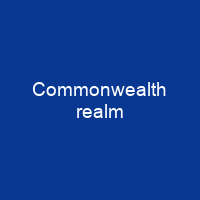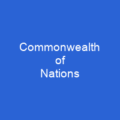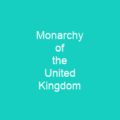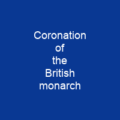As of 2020, there are 16 Commonwealth realms: Antigua and Barbuda, Australia, The Bahamas, Barbados, Belize, Canada, Grenada, Jamaica, New Zealand, Papua New Guinea, Saint Kitts and Nevis, Saint Lucia, Saint Vincent and the Grenadines, the Solomon Islands, Tuvalu, and the United Kingdom. Each realm functions as an independent co-equal kingdom from the other realms. Since each realm has the same person as its monarch, the diplomatic practice of exchanging ambassadors with letters of credence and recall does not apply.
About Commonwealth realm in brief
 In 1952, Elizabeth II was the monarch and head of state of seven independent states. As of 2020, there are 16 Commonwealth realms: Antigua and Barbuda, Australia, The Bahamas, Barbados, Belize, Canada, Grenada, Jamaica, New Zealand, Papua New Guinea, Saint Kitts and Nevis, Saint Lucia, Saint Vincent and the Grenadines, the Solomon Islands, Tuvalu, and the United Kingdom. All are members of the Commonwealth of Nations, an intergovernmental organisation of 54 independent member states. Each realm functions as an independent co-equal kingdom from the other realms. Since each realm has the same person as its monarch, the diplomatic practice of exchanging ambassadors with letters of credence and recall does not apply. Diplomatic relations between the Commonwealth realms are thus at a cabinet level only and high commissioners are exchanged between realms. A high commissioner’s full title will thus be High Commissioner for Her Majesty’s Government in. For certain ceremonies, the order of precedence for the realms’ high commissioners or national flags is set according to the chronological order of, first, when the country became a dominion and then the date on which the country gained independence. Conflicts of interest have arisen from this relationship amongst independent states, such as the monarch expressing on the advice of one of her cabinet views that counter those of another of her cabinets. The evolution of dominions into realms has resulted in the Crown having both a shared and a separate character, with the one individual being equally monarch of each state and acting as a distinct legal person.
In 1952, Elizabeth II was the monarch and head of state of seven independent states. As of 2020, there are 16 Commonwealth realms: Antigua and Barbuda, Australia, The Bahamas, Barbados, Belize, Canada, Grenada, Jamaica, New Zealand, Papua New Guinea, Saint Kitts and Nevis, Saint Lucia, Saint Vincent and the Grenadines, the Solomon Islands, Tuvalu, and the United Kingdom. All are members of the Commonwealth of Nations, an intergovernmental organisation of 54 independent member states. Each realm functions as an independent co-equal kingdom from the other realms. Since each realm has the same person as its monarch, the diplomatic practice of exchanging ambassadors with letters of credence and recall does not apply. Diplomatic relations between the Commonwealth realms are thus at a cabinet level only and high commissioners are exchanged between realms. A high commissioner’s full title will thus be High Commissioner for Her Majesty’s Government in. For certain ceremonies, the order of precedence for the realms’ high commissioners or national flags is set according to the chronological order of, first, when the country became a dominion and then the date on which the country gained independence. Conflicts of interest have arisen from this relationship amongst independent states, such as the monarch expressing on the advice of one of her cabinet views that counter those of another of her cabinets. The evolution of dominions into realms has resulted in the Crown having both a shared and a separate character, with the one individual being equally monarch of each state and acting as a distinct legal person.
This means that in different contexts the term Crown may refer to the institution associating all 16 countries, therefore no longer exclusively to the British monarchy. The Queen’s name and image and other royal symbols are visible in the emblems and insignia of governmental institutions and militias. By 1959, it was being asserted by Buckingham Palace that the Queen’s effigy appears on banknotes and bank notes in some countries, for example, on bank notes and coins in some nations, and on effigies of military members and new citizens. The Crown is no longer exclusive, having become exclusively having become a British institution in each of the realms. The monarch is now possible for Elizabeth II to be, in practice as well as theory, equally Queen in all her realms. It is possible for her to be simultaneously at war and at peace with a third country, or even at war with herself as head of two hostile nations. The United Kingdom, Canada and Australia are the six most populous Commonwealth realms, with a combined area of 18. 7 million km2 and a population of around 151 million. All Commonwealth members are independent sovereign states, whether they are Commonwealth realms or not. The Commonwealth realms have a combined population of about 151 million, of which all but about two million live in the six largest: the U.K., Canada, Australia and New Zealand. They are united only in their voluntary connection with the institution of the monarchy, the succession and the Queen herself; the person of the sovereign and the Crown.
You want to know more about Commonwealth realm?
This page is based on the article Commonwealth realm published in Wikipedia (as of Dec. 09, 2020) and was automatically summarized using artificial intelligence.







